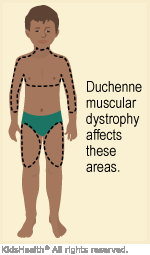Duchenne Muscular Dystrophy
What Is Duchenne Muscular Dystrophy?
Duchenne muscular dystrophy (also called Duchenne MD or DMD) is the most common form of muscular dystrophy, a genetic disorder that gradually makes the body’s muscles weaker.
What Are the Signs & Symptoms of Duchenne Muscular Dystrophy?
Children with Duchenne (dew-SHEN) MD may start walking later than average, and have large calves as toddlers. Often the disease goes unnoticed until age 3‒5, when muscle weakness affects walking, climbing steps, and other activities.
Children with Duchenne MD may:
- run slowly
- have trouble going up steps
- fall often
- toe walk (walking on the toes or balls of the feet)

Children with Duchenne MD also may have learning difficulties.
Duchenne MD is progressive, meaning problems get worse with age. As kids with DMD become teens, muscle weakness throughout the body can lead to heart and breathing problems.
What Causes Duchenne Muscular Dystrophy?
Duchenne MD happens because of a lack of dystrophin (dis-TRO-fin), a protein made by the muscle cells. In DMD, a variation or missing part of the dystrophin gene causes a loss of the dystrophin protein. This protein loss prevents the muscle fibers from working properly, leading to weakness.
Who Gets Duchenne Muscular Dystrophy?
Duchenne MD affects boys more often than girls because the dystrophin gene is on the X chromosome. Boys have only one X chromosome and girls have two. So girls can almost always make working dystrophin using the dystrophin gene on their second X chromosome.
But girls with a Duchenne MD gene may still have muscle cramps, weakness, and heart problems. Women with a deletion or variation in the gene are carriers and can pass this on to their children. Sometimes the variation or deletion in the gene does not come from the mother, but is a new change in the child. This is called a de novo or new variation.
How Is Duchenne Muscular Dystrophy Diagnosed?
Doctors often diagnose muscular dystrophy based on the child’s family history, symptoms, and an exam.
These tests confirm the diagnosis and determine the type of muscular dystrophy:
- Creatine kinase (CK) level: This blood test checks the level of creatine kinase, a protein that normally stays inside muscle cells. When Duchenne MD damages muscle cells, they release a lot of CK into the blood.
- Muscle biopsy: Doctors take a biopsy by removing a small piece of muscle, usually from the thigh. This test can show whether the muscular dystrophy is the Duchenne type or the milder Becker type.
- Genetic testing: This identifies the mistake in the dystrophin gene. This helps the medical team decide how to treat the problem and know what to expect in the future. If the genetic testing, CK level, and physical exam point to a diagnosis of DMD, a muscle biopsy may not be done.
How Is Duchenne Muscular Dystrophy Treated?
There’s no cure yet for Duchenne MD. Treatment can include:
- slowing the disease using medicines. Steroids improve function, and prednisone has been used for many years. Another steroid, called deflazacort (Emflaza®), was recently approved to treat DMD. Your doctor can tell you about the differences between these and which is best for your child.
- a new medicine called eteplirsen (Exondys 51™). This is approved for people who have a piece of the dystrophin gene missing. It works to skip over the missing piece of DNA and restore how much dystrophin protein the body makes. This is given weekly through an IV (into a vein) line. Many boys get this treatment at home after having the initial doses in the hospital.
- managing infections, breathing problems, scoliosis, and heart problems
- using devices such as nighttime braces to stretch the heel cords, and scooters or wheelchairs when walking distances becomes more difficult
A child with Duchenne MD usually is cared for by a team of doctors and other experts from several pediatric specialties.
What Can I Expect?
Treatment advances let kids with Duchenne MD live longer, more active lives than would have been possible 10 or 20 years ago.
Typically in Duchenne MD:
- Boys will start to use a wheelchair around age 10‒12 because of increasing muscle weakness and tiredness with walking.
- Breathing problems are carefully monitored with regular
pulmonary
function tests (PFTs) and sleep studies. A pulmonologist (lung specialist) will prescribe medicines to treat infections and improve breathing. Regular flu shots and pneumonia shots are recommended. - Heart function is monitored and medicines are given as needed to treat heart enlargement (cardiomyopathy) and irregular heart rhythms.
- An orthopedist (bone specialist) will do regular checks for scoliosis.
What Else Should I Know?
- Girls carrying a deletion or variation in the Duchenne MD gene should have regular visits with a pediatric cardiologist (a doctor who specializes in heart problems).
- Children with Duchenne MD may have a harmful response to anesthesia. If your child must have surgery, make sure the anesthesiologist knows about the DMD.
- Genetic counseling should be a consideration for any adult with a known deletion or variation in the Duchenne MD gene before having children.
- Many clinical trials and new medicines are being developed to treat and potentially cure Duchenne muscular dystrophy.
For more information about Duchenne muscular dystrophy, visit:
